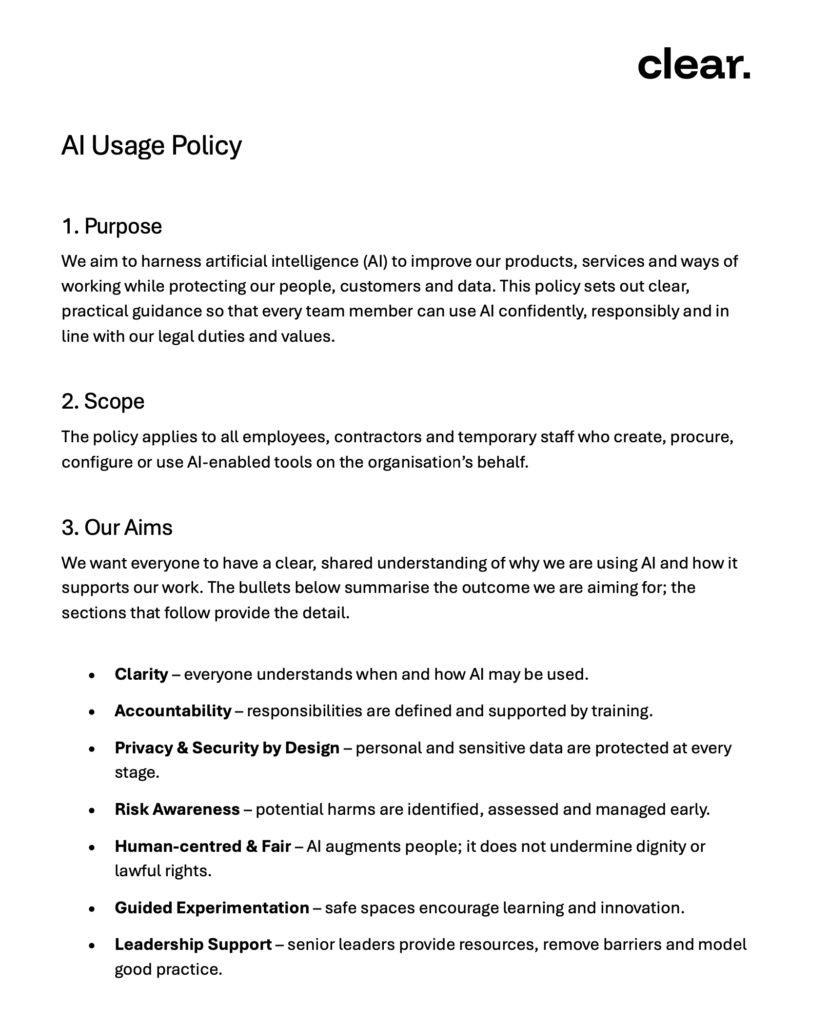In conference rooms across the country, a familiar scene plays out: leadership discusses AI strategy whilst teams quietly use ChatGPT to write emails, Claude to analyse data, and Midjourney to create presentations. This disconnect between official AI policy and actual AI usage represents one of the most significant risks facing modern organisations—Shadow AI.
Just as Shadow IT emerged when cloud services proliferated faster than IT departments could evaluate them, Shadow AI represents the unauthorised use of artificial intelligence tools by employees operating outside established governance processes. The difference is that whilst Shadow IT primarily posed infrastructure and security risks, Shadow AI introduces unprecedented challenges around data privacy, regulatory compliance, and algorithmic accountability.
Understanding Shadow AI
Shadow AI encompasses any use of artificial intelligence tools, applications, or services that haven’t been formally approved, vetted, or governed by an organisation’s IT or data governance teams. This includes everything from employees using consumer AI chatbots for work tasks to departments procuring AI-powered analytics tools without central oversight.
The phenomenon is remarkably widespread. Recent surveys suggest that over 70% of knowledge workers regularly use AI tools in their work, whilst fewer than 30% of organisations have comprehensive AI governance policies in place. This gap between adoption and governance creates a fertile environment for Shadow AI to flourish.
Unlike traditional software applications, AI tools often require no installation, procurement approval, or IT involvement. A marketing manager can start using an AI-powered content generation tool simply by creating an account with a credit card. A finance team can begin using an AI analytics platform without involving IT or legal teams. This ease of adoption, whilst democratising AI access, also bypasses the controls that traditionally protect organisations from unvetted technology risks.
The Scope of the Problem
The scale of Shadow AI usage often surprises leadership teams when they first attempt to audit their organisations’ actual AI usage. What appears as isolated individual experimentation frequently reveals itself as systematic, organisation-wide adoption of unvetted AI systems.
Departmental Proliferation
Different departments tend to gravitate toward AI tools that address their specific pain points, often without awareness of what other teams are using. Marketing teams adopt AI writing assistants, sales teams use AI-powered CRM enhancements, HR departments experiment with AI recruitment tools, and finance teams try AI-powered forecasting platforms. Each department believes they’re pioneering AI adoption whilst, in reality, the organisation is accumulating a complex web of unvetted AI dependencies.
Consumer Tool Migration
Many Shadow AI implementations begin with employees discovering consumer AI tools for personal use, then gradually incorporating them into work tasks. The transition from “I’ll just use ChatGPT to brainstorm ideas” to “I’ll have it analyse this confidential customer data” often happens imperceptibly, without consideration of the policy or security implications.
Vendor Creep
Software vendors increasingly embed AI capabilities into existing tools, sometimes without prominent disclosure. What begins as a familiar software platform can suddenly include AI features that fundamentally change how data is processed, stored, or analysed. Organisations may find themselves using AI systems without realising they’ve crossed that threshold.
The Multifaceted Risks of Shadow AI
Shadow AI introduces risks that extend far beyond traditional IT security concerns, touching on regulatory compliance, competitive intelligence, operational reliability, and strategic alignment.
Data Security and Privacy Vulnerabilities
The most immediate concern with Shadow AI is the potential exposure of sensitive data to unvetted systems. When employees input confidential information into consumer AI platforms, they may unknowingly share proprietary data with third-party providers who have no obligation to protect it.
Many consumer AI platforms explicitly state in their terms of service that user inputs may be used to train their models, essentially meaning that your confidential business information could become part of a publicly available AI system. Customer lists, financial data, strategic plans, and technical specifications all become potential training data for AI systems that competitors might later access.
The challenge is compounded by the fact that modern AI systems can infer sensitive information from seemingly innocuous inputs. Even anonymised or partial data can reveal patterns that compromise privacy or competitive advantage when processed by sophisticated AI algorithms.
Regulatory Compliance Gaps
Different industries face varying AI-related compliance requirements, and Shadow AI usage can inadvertently violate these regulations. Financial services organisations must comply with data handling requirements that may be compromised by unauthorised AI tools. Healthcare organisations face HIPAA implications when patient data is processed through unvetted AI systems. European organisations must consider GDPR implications when personal data is shared with AI platforms.
The emerging EU AI Act introduces additional compliance complexities, categorising AI systems by risk level and imposing specific obligations on operators of high-risk AI systems. Organisations using Shadow AI may unknowingly operate high-risk AI systems without implementing required safeguards, documentation, or monitoring processes.
Operational Dependencies and Reliability Risks
Shadow AI tools often become embedded in critical business processes without appropriate backup plans or service level agreements. When a free AI tool changes its terms of service, increases pricing, or becomes unavailable, it can disrupt operations in ways that formal IT systems are designed to prevent.
These dependencies are particularly problematic because they’re often invisible to leadership and IT teams. A critical report that relies on Shadow AI analysis might fail to generate, but the root cause may not be immediately apparent to those responsible for business continuity.
Bias and Accuracy Concerns
AI systems can perpetuate or amplify biases present in their training data, leading to discriminatory outcomes in hiring, customer service, or other business decisions. When Shadow AI tools are used for consequential decisions without proper vetting, organisations risk creating bias-driven outcomes that could result in legal liability or reputational damage.
Similarly, the accuracy and reliability of Shadow AI outputs often go unvalidated. Employees may make important business decisions based on AI analyses that contain errors, outdated information, or flawed reasoning—risks that formal AI governance processes are designed to mitigate.
Financial and Resource Inefficiencies
Shadow AI often leads to duplicated spending as different departments procure similar tools without coordination. The cumulative cost of numerous individual AI subscriptions frequently exceeds what organisations would pay for enterprise-grade solutions that provide better security, integration, and management capabilities.
Beyond direct costs, Shadow AI creates hidden expenses through the time employees spend learning and managing multiple disparate tools, the effort required to integrate outputs from different systems, and the opportunity cost of not leveraging AI capabilities systematically across the organisation.
Industry-Specific Shadow AI Challenges
Different sectors face unique Shadow AI risks based on their regulatory environments, data sensitivity, and operational requirements.
Financial Services
Banks and financial institutions face particular challenges with Shadow AI due to strict regulatory requirements around data handling, algorithmic decision-making, and audit trails. Customer financial data processed through unauthorised AI tools can violate multiple regulations simultaneously, whilst AI-driven investment or lending recommendations made through Shadow AI systems may lack the documentation required for regulatory compliance.
Healthcare
Healthcare organisations using Shadow AI risk HIPAA violations when patient data is processed through unvetted systems. Medical professionals using AI tools for diagnostic support or treatment recommendations without proper validation create liability risks that extend beyond regulatory compliance to patient safety concerns.
Legal Services
Law firms face unique challenges as client confidentiality requirements may be compromised by Shadow AI usage, whilst the use of AI for legal research or document generation without proper vetting could introduce errors that have significant consequences for client outcomes.
Manufacturing and Engineering
Manufacturing organisations using Shadow AI for process optimisation or quality control risk operational disruptions if unvetted AI systems provide flawed recommendations. Intellectual property concerns are particularly acute when proprietary designs or processes are shared with external AI platforms.
The Psychology Behind Shadow AI Adoption
Understanding why employees turn to Shadow AI despite policy restrictions is crucial for developing effective governance strategies. The motivations are typically logical and well-intentioned, making blanket prohibition ineffective.
Productivity Pressure
Employees face increasing pressure to deliver more value with limited resources. AI tools offer compelling productivity improvements that can help individuals meet these expectations. When official AI tools aren’t available or are slow to be approved, Shadow AI becomes an attractive alternative for meeting performance targets.
Innovation Enthusiasm
Many employees are genuinely excited about AI’s potential and want to contribute to their organisation’s digital transformation. In the absence of official channels for AI experimentation, they pursue innovation through available tools, often unaware of the risks they’re creating.
Bureaucratic Frustration
Traditional IT procurement processes can be slow and cumbersome, particularly for new technology categories like AI. Employees who see immediate opportunities to improve their work may resort to Shadow AI rather than navigate lengthy approval processes.
Competitive Anxiety
Awareness that competitors are using AI creates pressure to adopt AI tools quickly. Employees may justify Shadow AI usage as necessary for competitive survival, prioritising speed over governance.
Detection and Discovery Strategies
Identifying Shadow AI usage requires a multi-faceted approach that combines technological monitoring with cultural engagement and process review.
Network and Usage Monitoring
IT teams can implement monitoring tools that identify connections to known AI platforms and services. Network traffic analysis can reveal usage patterns that suggest AI tool adoption, whilst endpoint monitoring can detect installed AI applications or browser-based AI usage.
Financial Audit Approaches
Regular review of expense reports and procurement cards can reveal AI-related subscriptions that weren’t formally approved. Many Shadow AI implementations leave financial traces through subscription payments that can be identified through systematic expense analysis.
Employee Surveys and Engagement
Anonymous surveys can provide insights into actual AI usage patterns whilst creating opportunities for education about governance requirements. These surveys often reveal the gap between official policy and actual practice, providing valuable data for developing more effective governance approaches.
Process Documentation Reviews
Regular review of business processes and documentation can reveal dependencies on AI tools that weren’t formally recognised. When process descriptions include steps that seem surprisingly efficient or sophisticated, they may indicate Shadow AI usage.
From Discovery to Governance
Discovering Shadow AI usage is only the first step toward establishing effective AI governance. The response must balance risk mitigation with support for legitimate productivity and innovation needs.
Risk Assessment and Prioritisation
Not all Shadow AI usage presents equal risk. Consumer AI tools used for brainstorming may pose minimal risk, whilst AI tools processing sensitive customer data require immediate attention. Effective governance starts with systematic risk assessment that prioritises the most critical vulnerabilities.
Policy Development and Communication
Clear, practical AI usage policies help employees understand acceptable use boundaries whilst providing pathways for legitimate AI needs. These policies should address common use cases, explain risk considerations, and provide clear escalation procedures for situations not covered by existing guidelines.
Alternative Solution Provision
Effective Shadow AI governance requires providing legitimate alternatives that meet employee needs while maintaining appropriate oversight. This might include procuring enterprise-grade AI tools, establishing AI sandbox environments, or creating fast-track approval processes for low-risk applications.
Training and Awareness Programs
Employees often use Shadow AI because they don’t understand the risks or alternatives. Comprehensive training programs that explain governance requirements whilst demonstrating approved AI capabilities can significantly reduce Shadow AI adoption.
The Role of AI Management Systems in Shadow AI Prevention
AI Management Systems provide systematic approaches to preventing Shadow AI whilst supporting legitimate AI innovation. Rather than simply restricting AI usage, effective AIMS create pathways for safe, productive AI adoption.
Comprehensive AI Inventory and Monitoring
AIMS platforms provide visibility into actual AI usage across the organisation, helping identify Shadow AI implementations before they create significant risks. This monitoring capability extends beyond simple network analysis to include integration with procurement systems, expense tracking, and employee reporting mechanisms.
Policy Automation and Enforcement
Modern AIMS platforms can automate policy enforcement through integration with network security tools, endpoint management systems, and cloud access security brokers. This technical enforcement reduces reliance on employee compliance whilst providing clear feedback about policy violations.
Innovation Facilitation
Rather than simply preventing unauthorised AI usage, effective AIMS provide structured pathways for AI experimentation and adoption. This includes sandbox environments, fast-track approval processes, and curated catalogs of approved AI tools that meet common business needs.
Risk Assessment and Mitigation
AIMS platforms provide frameworks for systematically assessing AI-related risks and implementing appropriate mitigation strategies. This structured approach helps organisations make informed decisions about which AI tools to approve, restrict, or prohibit.
Building a Shadow AI Prevention Strategy
Effective Shadow AI prevention requires a comprehensive strategy that addresses both technical and cultural aspects of AI governance.
Executive Leadership and Culture
Successful Shadow AI prevention starts with executive recognition of the challenge and commitment to systematic AI governance. Leadership must communicate the importance of AI governance whilst demonstrating support for legitimate AI innovation.
Cross-Functional Governance Teams
Shadow AI prevention requires collaboration between IT, legal, compliance, and business teams. Cross-functional governance teams ensure that AI policies address technical, regulatory, and operational requirements whilst remaining practical for daily business operations.
Continuous Monitoring and Adaptation
The AI landscape evolves rapidly, with new tools and capabilities emerging regularly. Effective Shadow AI prevention requires continuous monitoring of technology trends, usage patterns, and regulatory requirements, with governance policies updated accordingly.
Employee Engagement and Feedback
Sustainable Shadow AI prevention requires ongoing employee engagement and feedback. Regular surveys, focus groups, and feedback sessions help ensure that governance policies remain practical and effective whilst identifying emerging needs that require attention.
Conclusion
Shadow AI represents one of the most significant governance challenges facing modern organisations. The combination of easy access to powerful AI tools, pressure for productivity improvements, and gaps in traditional governance processes creates conditions where Shadow AI flourishes despite potential risks.
However, Shadow AI isn’t simply a problem to be eliminated—it’s a symptom of legitimate business needs that aren’t being met through official channels. Effective governance requires understanding these needs whilst implementing systematic approaches that balance innovation support with risk management.
The organisations that successfully address Shadow AI will be those that implement comprehensive AI Management Systems providing visibility, control, and structured pathways for AI adoption. These systems don’t just prevent risks—they create competitive advantages through systematic, governed AI implementation that scales safely across the organisation.
The cost of ignoring Shadow AI continues to accumulate daily through security vulnerabilities, compliance gaps, operational dependencies, and missed opportunities for systematic AI leverage. The question isn’t whether your organisation has Shadow AI—it’s whether you’ll address it proactively or wait until it becomes a crisis requiring immediate remediation.
Clear provides the comprehensive AI Management System capabilities needed to transform Shadow AI from a hidden risk into a managed opportunity. With full governance, innovation, training, and reporting suites, Clear enables organisations to gain visibility into actual AI usage whilst providing structured pathways for safe AI adoption. The platform’s expert support ensures you’re not navigating AI governance challenges alone, whilst the systematic approach to AI management creates the foundation for long-term competitive advantage through responsible AI innovation.


